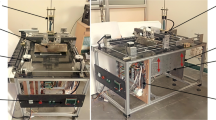Abstract
Shrinkage, one of the typical phenomena in the selective laser sintering (SLS) process, affects the final dimensional accuracy of SLS products. We investigated the relationship between the shrinkage and the process parameters of SLS in order to improve dimensional accuracy. According to the characteristic of SLS, the following process parameters are considered: layer thickness, hatch spacing, laser power, scanning speed, temperature of working environment, interval time and scanning mode. A neural network model on the relationship between the processing parameters and shrinkage was built on the basis of a series of experiments. The experimental investigation results show that the neural network model is possible to be used to predict the effects of the process parameters on the shrinkage with reasonable accuracy and to analyze the relationship between the shrinkage and the process parameters of SLS quantitatively. So it is suitable to apply neural networks approach to study the SLS process. This model will allow us to produce the SLS parts with the desired quality attributed by selecting the appropriate parameter values prior the processing. This paper proposes a promising approach to improve the accuracy of the SLS part.
Similar content being viewed by others
References
Wang XC, Laoui T, Bonse J et al (2002) Direct selective laser sintering of hard metal powders: experimental study and simulation. Int J Adv Manuf Technol 19:351–357
Tang Y, Loh HT, Fuh JYH et al (2005) An algorithm for disintegrating large and complex rapid prototyping objects in a CAD environment. Int J Adv Manuf Technol 25:895–901
Boillat E, Kolossov S, Glardon R (2004) Finite element and neural network models for process optimization in selective laser sintering. Proc Inst Mech Eng B J Eng Manuf 218:607–614
Wang XC, Laoui T, Bonse J et al (2002) Direct selective laser sintering of hard metal powders: experimental study and simulation. Int J Adv Manuf Technol 19:351–357
Childs THC, Berzins M, Ryder GR et al (1999) Selective laser sintering of an amorphous polymer-simulations and experiments. Proc Inst Mech Eng Part B 213:333–349
Onuh SO, Hon KKB (1998) Optimizing build parameters for improved surface finish in stereolithography. Int J Mach Tools Manuf 38(4):329–345
Li Xiang-sheng, Han Min, Shi Yu-sheng et al (2001) Model of shrinking and curl distortion for SLS prototypes. Chi Hsieh Kung Ch’eng Hsueh Pao 12(8):887–889
Williams JD, Decard CR (1998) Advances in modeling the effects of selected parameters on the SLS process. Rapid Prototyping J 4(2):90–96
Yang H-J, Huang P-J, Lee S-H (2002) A study on shrinkage compensation of SLS process by using the Taguchi method. Int J Mach Tools Manuf 42:1203–1212
Masood SH, Ratanaway W, Iovenitti P (2003) A genetic algorithm for best part orientation system for complex parts in rapid prototyping. J Mater Process Technol 139:110–116
Tumer Iron Y, Kristin L, Wood Iiene J, Busch-Vishniac (1995) Modeling of dynamic effects caused by the beam delivery system in selective laser sintering. Proceedings of the 1995 solid freeform fabrication symposium, Tx, Austin, pp 353–361
Arni RK, Gupta SK (1999) Manufacturability analysis for solid freeform fabrication. Proceedings of the ASME Design Engineering Technical Conference. Las Vegas, Nevada, USA, pp 1–12
Armillotta A, Biggioggero GF (2001) Control of prototyping surface finish through graphical simulation. Proceedings of the VII ADM International conferences, Grand Hotel, Rimini, Italy, pp 17–24
Hornik K, Stinchcombe M, White H (1989) Multilayer feedforward networks are universal approximators. Neural Netw 2:359–366
Shi Y, Zhong Q, Chen X (2002) Research and implement of a new kind of scanning mode for selective laser sintering. Chi Hsieh Kung Ch’eng Hsueh Pao 38:35–39
Author information
Authors and Affiliations
Corresponding author
Rights and permissions
About this article
Cite this article
Wang, RJ., Wang, L., Zhao, L. et al. Influence of process parameters on part shrinkage in SLS. Int J Adv Manuf Technol 33, 498–504 (2007). https://doi.org/10.1007/s00170-006-0490-x
Received:
Accepted:
Published:
Issue Date:
DOI: https://doi.org/10.1007/s00170-006-0490-x




